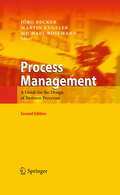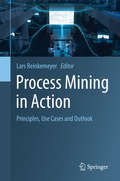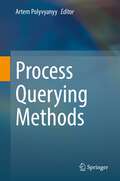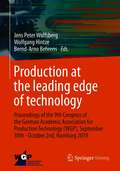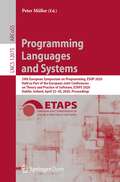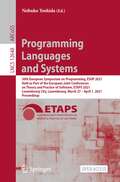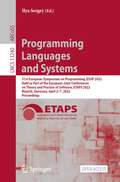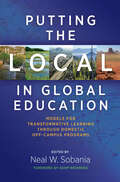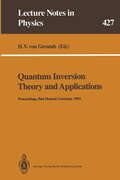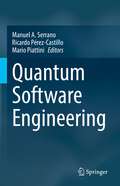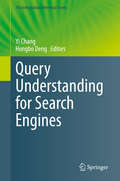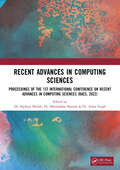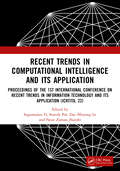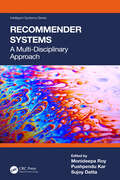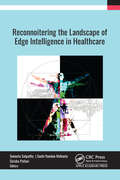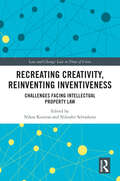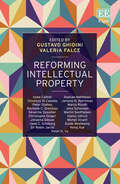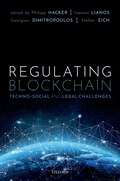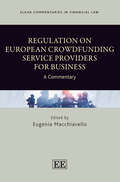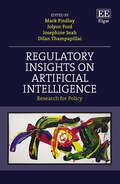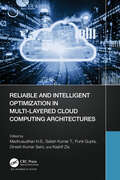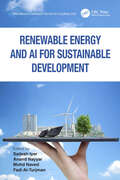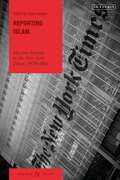- Table View
- List View
Process Management: A Guide for the Design of Business Processes
"Process Management" is a compendium for modern design of process-oriented companies. A hands-on approach to introducing, realizing and continually administering process management is presented with a thoroughly critical reflection of the necessary activities regarding the state-of-the-art of organization theory and information management. This is done by following the individual stages of a process model which has already successfully been proved in practice. The progress of the project is described by a continuous case study, which is the process management project of a modern service company. The included recommendations are summarized in a series of checklists for each stage of the project.
Process Mining in Action: Principles, Use Cases and Outlook
This book describes process mining use cases and business impact along the value chain, from corporate to local applications, representing the state of the art in domain know-how. Providing a set of industrial case studies and best practices, it complements academic publications on the topic. Further the book reveals the challenges and failures in order to offer readers practical insights and guidance on how to avoid the pitfalls and ensure successful operational deployment.The book is divided into three parts: Part I provides an introduction to the topic from fundamental principles to key success factors, and an overview of operational use cases. As a holistic description of process mining in a business environment, this part is particularly useful for readers not yet familiar with the topic. Part II presents detailed use cases written by contributors from a variety of functions and industries. Lastly, Part III provides a brief overview of the future of process mining, both from academic and operational perspectives.Based on a solid academic foundation, process mining has received increasing interest from operational businesses, with many companies already reaping the benefits. As the first book to present an overview of successful industrial applications, it is of particular interest to professionals who want to learn more about the possibilities and opportunities this new technology offers. It is also a valuable resource for researchers looking for empirical results when considering requirements for enhancements and further developments.
Process Querying Methods
This book presents a framework for developing as well as a comprehensive collection of state-of-the-art process querying methods. Process querying combines concepts from Big Data and Process Modeling and Analysis with Business Process Intelligence and Process Analytics to study techniques for retrieving and manipulating models of real-world and envisioned processes to organize and extract process-related information for subsequent systematic use. The book comprises sixteen contributed chapters distributed over four parts and two auxiliary chapters. The auxiliary chapters by the editor provide an introduction to the area of process querying and a summary of the presented methods, techniques, and applications for process querying. The introductory chapter also examines a process querying framework. The contributed chapters present various process querying methods, including discussions on how they instantiate the framework components, thus supporting the comparison of the methods. The four parts are due to the distinctive features of the methods they include. The first three are devoted to querying event logs generated by IT-systems that support business processes at organizations, querying process designs captured in process models, and methods that address querying both event logs and process models. The methods in these three parts usually define a language for specifying process queries. The fourth part discusses methods that operate over inputs other than event logs and process models, e.g., streams of process events, or do not develop dedicated languages for specifying queries, e.g., methods for assessing process model similarity. This book is mainly intended for researchers. All the chapters in this book are contributed by active researchers in the research disciplines of business process management, process mining, and process querying. They describe state-of-the-art methods for process querying, discuss use cases of process querying, and suggest directions for future work for advancing the field. Yet, also other groups like business or data scientists and other professionals, lecturers, graduate students, and tool vendors will find relevant information for their distinctive needs.Chapter "Celonis PQL: A Query Language for Process Mining" is available open access under a Creative Commons Attribution 4.0 International License via link.springer.com.
Production at the leading edge of technology: Proceedings of the 9th Congress of the German Academic Association for Production Technology (WGP), September 30th - October 2nd, Hamburg 2019
The focus of the Congress will be leading-edge manufacturing processes. Topics include manufacturing at extreme speed, size, accuracy, methodology, use of resources, interdisciplinarity and more. Contributions from production and industrial engineering are welcome. Challenges from the areas of manufacturing, machines and production systems will be addressed. Production research constantly pushes the boundaries of what is feasible. The Congress "Production at the leading edge of technology" will highlight production processes that are advancing into areas that until recently were considered unfeasible, also in terms of methodology, use of resources and interdisciplinarity. But where does the search for new limits lead? Which limitations do we still have to overcome, which ones do we not want to overcome? The aim of the German-speaking colloquium is to establish connections between the research locations and to intensify the overall transfer of results and experience with industrial users.
Programming Languages and Systems: 29th European Symposium on Programming, ESOP 2020, Held as Part of the European Joint Conferences on Theory and Practice of Software, ETAPS 2020, Dublin, Ireland, April 25–30, 2020, Proceedings (Lecture Notes in Computer Science #12075)
This open access book constitutes the proceedings of the 29th European Symposium on Programming, ESOP 2020, which was planned to take place in Dublin, Ireland, in April 2020, as Part of the European Joint Conferences on Theory and Practice of Software, ETAPS 2020. The actual ETAPS 2020 meeting was postponed due to the Corona pandemic. The papers deal with fundamental issues in the specification, design, analysis, and implementation of programming languages and systems.
Programming Languages and Systems: 30th European Symposium on Programming, ESOP 2021, Held as Part of the European Joint Conferences on Theory and Practice of Software, ETAPS 2021, Luxembourg City, Luxembourg, March 27 – April 1, 2021, Proceedings (Lecture Notes in Computer Science #12648)
This open access book constitutes the proceedings of the 30th European Symposium on Programming, ESOP 2021, which was held during March 27 until April 1, 2021, as part of the European Joint Conferences on Theory and Practice of Software, ETAPS 2021. The conference was planned to take place in Luxembourg and changed to an online format due to the COVID-19 pandemic. The 24 papers included in this volume were carefully reviewed and selected from 79 submissions. They deal with fundamental issues in the specification, design, analysis, and implementation of programming languages and systems.
Programming Languages and Systems: 31st European Symposium on Programming, ESOP 2022, Held as Part of the European Joint Conferences on Theory and Practice of Software, ETAPS 2022, Munich, Germany, April 2–7, 2022, Proceedings (Lecture Notes in Computer Science #13240)
This open access book constitutes the proceedings of the 31st European Symposium on Programming, ESOP 2022, which was held during April 5-7, 2022, in Munich, Germany, as part of the European Joint Conferences on Theory and Practice of Software, ETAPS 2022. The 21 regular papers presented in this volume were carefully reviewed and selected from 64 submissions. They deal with fundamental issues in the specification, design, analysis, and implementation of programming languages and systems.
Putting the Local in Global Education: Models for Transformative Learning Through Domestic Off-Campus Programs
The position taken in this volume is that domestic off-campus study can be just as powerful a transformative learning experience as study overseas, and that domestic programs can equally expand students’ horizons, their knowledge of global issues and processes, their familiarity and experience with cultural diversity, their intercultural skills, and sense of citizenship.This book presents both the rationale for and examples of “study away”, an inclusive concept that embraces study abroad while advocating for a wide variety of domestic study programs, including community-based education programs that employ academic service-learning and internships.With the growing diversification—regionally, demographically, culturally, and socio-economically—of developed economies such as the US, the local is potentially a “doorstep to the planet” and presents opportunities for global learning. Moreover, study away programs can address many of the problematic issues associated with study abroad, such as access, finance, participation, health and safety, and faculty support. Between lower costs, the potential to increase the participation of student cohorts typically under-represented in study abroad, the lowering of language barriers, and the engagement of faculty whose disciplines focus on domestic issues, study at home can greatly expand the reach of global learning.The book is organized in five sections, the first providing a framework and the rationale for domestic study way programs; addressing administrative support for domestic vs. study abroad programs; exploring program goals, organization, structure, assessment and continuous improvement; and considering the distinct pedagogies of experiential and transformative education.The second section focuses on Semester Long Faculty Led Programs, featuring examples of programs located in a wide variety of locations – from investigations into history, immigration, culture, and the environment through localities in the West and the Lowcountry to exploring globalization in L.A and New York. Section three highlights five Short Term Faculty Led Programs. While each includes an intensive immersive study away experience, two illustrate how a 7 – 10 day study away experience can be effectively embedded into a regular course taught on campus. The fourth section, on Consortium Programs, describes programs that are either sponsored by a college that makes its program available to consortium members and non-members, or is offered by an independent non-for-profit to which institutions send their students. The final section on Community Engagement and Domestic Study Away addresses the place of community-based education in global learning and provides examples of academic programs that employ service-learning as a tool for collaborative learning, focusing on issues of pedagogy, faculty development and the building long-term reciprocal relationship with community partners to co-create knowledge.The book is intended for study abroad professionals, multicultural educators, student affairs professionals, alternative spring break directors, and higher education administrators concerned about affordably expanding global education opportunities.
Quantum Inversion Theory and Applications: Proceedings of the 109th W.E. Heraeus Seminar Held at Bad Honnef, Germany, May 17–19, 1993 (Lecture Notes in Physics #427)
This volume covers aspects of Schr|dinger equation inversion for the purposeof determining interaction potentials in particle, nuclear and atomic physics from experimental data. It includes reviews and reports on the latest developments in mathematics, supersymmetric quantum mechanics, inversion for fixed-l nucleon-nucleon potentials, inversion of fixed-E optical potentials and their generalizations. Also included are some topics on nonlinear differential equations relating to theSchr|dinger or other equations of particle, nuclear, atomic and molecular physics which can be solved by inverse scattering transformations. The material collected in this volume gives a clear picture of the status ofresearch in this rapidly growing field. The book addresses students and young scientists as well as researchers in theoretical physics and functional analysis.
Quantum Software Engineering
This book presents a set of software engineering techniques and tools to improve the productivity and assure the quality in quantum software development. Through the collaboration of the software engineering community with the quantum computing community new architectural paradigms for quantum-enabled computing systems will be anticipated and developed.The book starts with a chapter that introduces the main concepts and general foundations related to quantum computing. This is followed by a number of chapters dealing with the quantum software engineering methods and techniques. Topics like the Talavera Manifesto for quantum software engineering, frameworks for hybrid systems, formal methods for quantum software engineering, quantum software modelling languages, and reengineering for quantum software are covered in this part. A second set of chapters then deals with quantum software environments and tools, detailing platforms like QuantumPath®, Classiq as well as quantum software frameworks for deep learning. Overall, the book aims at academic researchers and practitioners involved in the creation of quantum information systems and software platforms. It is assumed that readers have a background in traditional software engineering and information systems.
Query Understanding for Search Engines (The Information Retrieval Series #46)
This book presents a systematic study of practices and theories for query understanding of search engines. These studies can be categorized into three major classes. The first class is to figure out what the searcher wants by extracting semantic meaning from the searcher’s keywords, such as query classification, query tagging, and query intent understanding. The second class is to analyze search queries and then translate them into an enhanced query that can produce better search results, such as query spelling correction or query rewriting. The third class is to assist users in refining or suggesting queries in order to reduce users’ search effort and satisfy their information needs, such as query auto-completion and query suggestion.Query understanding is a fundamental part of search engines. It is responsible to precisely infer the intent of the query formulated by the search user, to correct spelling errors in his/her query, to reformulate the query to capture its intent more accurately, and to guide the user in formulating a query with precise intent.The book will be invaluable to researchers and graduate students in computer or information science and specializing in information retrieval or web-based systems, as well as to researchers and programmers working on the development or improvement of products related to search engines.
Ray Tracing Gems II: Next Generation Real-Time Rendering with DXR, Vulkan, and OptiX
The digital version of this book is available now for free – with the print version following very soon!This Open Access book is a must-have for anyone interested in real-time rendering. Ray tracing is the holy grail of gaming graphics, simulating the physical behavior of light to bring real-time, cinematic-quality rendering to even the most visually intense games. Ray tracing is also a fundamental algorithm used for architecture applications, visualization, sound simulation, deep learning, and more.Ray Tracing Gems II is written by industry experts with a particular focus on ray tracing, and it offers a practical means to master the new capabilities of current and future GPUs with the latest graphics APIs.What You'll Learn:The latest ray tracing techniques for developing real-time applications in multiple domainsCase studies from developers and studios who have shipped products that use real-time ray tracing.Guidance, advice and best practices for rendering applications with various GPU-based ray tracing APIs (DirectX Raytracing, Vulkan Ray Tracing)High performance graphics for 3D graphics, virtual reality, animation, and moreWho This Book Is For:Game and graphics developers who are looking to leverage the latest hardware and software tools for real-time rendering and ray tracing to enhance their applications across a variety of disciplines.
Recent Advances in Computing Sciences: Proceedings of RACS 2022
The 1st International Conference on Recent Advances in Computing Sciences (RACS-2022) organized by the School ofComputer Application, Lovely Professional University, Jalandhar, Punjab from 4th to 5th November, 2022.The conference focuses on discussing issues, exchanging ideas, and the most recent innovations towards the advancementof research in the field of Computing Sciences and Technology. All technical sessions were predominantlyrelated to Data Science, Artificial Intelligence, Remote Sensing, Image Processing, Computer Vision, Data Forensics,Cyber Security, Computational Sciences, Simulation & Modelling, Business Analytics, and Machine Learning.The main objective of this conference is to provide a common platform for academia and industry to discuss varioustechnological challenges and share cognitive thoughts. It provided a thought-provoking platform to discuss anddisseminate novel solutions for real-world problems in a dynamic and changing technological environment. The mainsuccess of RACS-2022 is to give an opportunity for the participants to enhance their knowledge of recent computingtechnologies.
Recent Trends in Computational Intelligence and Its Application: Proceedings of the 1st International Conference on Recent Trends in Information Technology and its Application (ICRTITA, 22) (Conference Proceedings Series on Intelligent Systems, Data Engineering, and Optimization)
The increase in computing power and sensor data has driven Information Technology on end devices, such as smart phones or automobiles. The widespread application of IT across the globe includes manufacturing, engineering, retail, e-commerce, health care, education, financial services, banking, space exploration, politics (to help predict the sentiments of voter demographics), etc. The papers in this conference proceeding examine and discuss various interdisciplinary researches that could accelerate the advent of Information Technology.
Recommender Systems: A Multi-Disciplinary Approach (Intelligent Systems)
Recommender Systems: A Multi-Disciplinary Approach presents a multi-disciplinary approach for the development of recommender systems. It explains different types of pertinent algorithms with their comparative analysis and their role for different applications. This book explains the big data behind recommender systems, the marketing benefits, how to make good decision support systems, the role of machine learning and artificial networks, and the statistical models with two case studies. It shows how to design attack resistant and trust-centric recommender systems for applications dealing with sensitive data. Features of this book: Identifies and describes recommender systems for practical uses Describes how to design, train, and evaluate a recommendation algorithm Explains migration from a recommendation model to a live system with users Describes utilization of the data collected from a recommender system to understand the user preferences Addresses the security aspects and ways to deal with possible attacks to build a robust system This book is aimed at researchers and graduate students in computer science, electronics and communication engineering, mathematical science, and data science.
Reconnoitering the Landscape of Edge Intelligence in Healthcare
The revolution in healthcare as well as demand for efficient real-time healthcare services are driving the progression of edge computing, AI-mediated techniques, deep learning, and IoT applications for healthcare industries and cloud computing. Edge computing helps to meet the demand for newer and more sophisticated healthcare systems that are more personalized and that match the speed of modern life. With applications of edge computing, automated intelligence and intuitions are incorporated into existing healthcare analysis tools for identifying, forecasting, and preventing high-risk diseases.Reconnoitering the Landscape of Edge Intelligence in Healthcare provides comprehensive research on edge intelligence technology with the emphasis on application in the healthcare industry. It covers all the various areas of edge intelligence for data analysis in healthcare, looking at the emerging technologies such as AI-based techniques, machine learning, IoT, cloud computing, and deep learning with illustrations of the design, implementation, and management of smart and intelligent healthcare systems.Chapters showcase the advantages and highlights of the adoption of the intelligent edge models toward smart healthcare infrastructure. The book also addresses the increased need for a high level of medical data security while transferring real-time data to cloud-based architecture, a matter of prime concern for both patient and doctor. Topics include edge intelligence for wearable sensor technologies and their applications for health monitoring, the various edge computing techniques for disease prediction, e-health services and e-security solutions through IoT devices that aim to improve the quality of care for transgender patients, smart technology in ambient assisted living, the role of edge intelligence in limiting virus spread during pandemics, neuroscience in decoding and analysis of visual perception from the neural patterns and visual image reconstruction, and more.The technology addressed include energy aware cross-layer routing protocol (ECRP), OMKELM-IDS technique, graphical user interface (GUI), IOST (an ultra-fast, decentralized blockchain platform), etc.This volume will be helpful to engineering students, research scholars, and manufacturing industry professionals in the fields of engineering applications initiatives on AI, machine learning, and deep learning techniques for edge computing.
Recreating Creativity, Reinventing Inventiveness: AI and Intellectual Property Law (Law and Change)
As artificial intelligence (AI) is increasingly used to generate inventions and creative works, a critical question to be addressed is whether intellectual property (IP) laws should protect such works. This book examines the critical question of whether intellectual property laws should protect works generated by artificial intelligence.If we do not wish to use IP laws to protect such works, how can we still support research, development, and innovation in society? If we do wish to use IP laws to protect such works, should the copyright, patents, and other IP rights attach to the human creator of the AI technology or the AI system? The book explores these compelling societal, economic, and legal issues. The authors evaluate the continuing relevance of existing laws, explore the divergent approaches being debated by nations around the world, and present visions for change.The book will enable both lawyers and non-lawyers to reimagine governance frameworks to create laws that equitably balance the interests of creators, investors, and end users of AI-generated works.
Reforming Intellectual Property
Reforming Intellectual Property brings together 19 of the world’s leading scholars in the field to offer their unique insight into the future of intellectual property. Providing a diverse array of perspectives on the most pressing reforms needed in the current IP regime, whether in terms of legislation at national and international levels, or interpretation of existing law, this exceptional book highlights the key issues in this area and sets out an agenda for future research and policy.Examining the question of what changes to IP law and policy are most urgent and would have the most impact, chapters cover a wide range of subjects, with some focusing on specific topics such as the reform of non-traditional trademarks, or the fair use and research exemption in patent law. Other contributions take a broader approach, such as a reappraisal of performers’ rights in audio and audiovisual media that encompasses implications for creativity, welfare and ethics in the film industry, and a proposal for the creation of an International Intellectual Property Treaty.This book will prove to be crucial reading for all scholars and students of IP law, as well as policymakers and practitioners in the field. It will also be of interest to researchers working in related fields such as competition and human rights law for its intersecting analysis of these areas.
Regulating Blockchain: Techno-Social and Legal Challenges
Less than a decade after the Financial Crisis, we are witnessing the fast emergence of a new financial order driven by three different, yet interconnected, dynamics: first, the rapid application of technology - such as big data, machine learning, and distributed computing - to banking, lending, and investing, in particular with the emergence of virtual currencies and digital finance; second, a disintermediation fuelled by the rise of peer-to-peer lending platforms and crowd investment which challenge the traditional banking model and may, over time, lead to a transformation of the way both retail and corporate customers bank; and, third, a tendency of de-bureaucratisation under which new platforms and technologies challenge established organisational patterns that regulate finance and manage the money supply. These changes are to a significant degree driven by the development of blockchain technology. The aim of this book is to understand the technological and business potential of the blockchain technology and to reflect on its legal challenges. The book mainly focuses on the challenges blockchain technology has so far faced in its first application in the areas of virtual money and finance, as well as those that it will inevitably face (and is partially already facing, as the SEC Investigative Report of June 2017 and an ongoing SEC securities fraud investigation show) as its domain of application expands in other fields of economic activity such as smart contracts and initial coin offerings. The book provides an unparalleled critical analysis of the disruptive potential of this technology for the economy and the legal system and contributes to current thinking on the role of law in harvesting and shaping innovation.
Regulation on European Crowdfunding Service Providers for Business: A Commentary (Elgar Commentaries in Financial Law series)
This innovative Commentary boasts contributions from internationally renowned experts with extensive and diverse backgrounds, providing a comprehensive, critical, article-by-article and thematic analysis of the EU Regulation No 1503/2020 on European Crowdfunding Service Providers for Business (ECSPR). Chapters analyse Member States’ adaptation of their legal frameworks to the ECSPR, underlying similarities, divergences, additional problematic issues and residual regulatory fragmentation.Key Features:A theoretical and cross-sectoral approach to crowdfunding services and relative regulationsConstant comparison of ECSPR’s provisions with other similar or interrelated EU frameworksAn article-by-article and thematic analysis of the ECSPR, underlying its strengths, innovative characters and problematic aspectsAnalysis of the implementation of the ECSPR in different countries and adaptation of their legal frameworks, including France, Germany, Italy, Portugal, Spain, the Netherlands, Nordic countries and the Baltics The Commentary is a fundamental companion to the interpretation and application of the ECSPR which will appeal to a diverse range of readers. Academics, scholars, practitioners and professionals interested in financial regulation, EU law, technology law, business law, law of contracts, competition law, international law and comparative law will find this a beneficial resource.
Regulatory Insights on Artificial Intelligence: Research for Policy
This provocative book investigates the relationship between law and artificial intelligence (AI) governance, and the need for new and innovative approaches to regulating AI and big data in ways that go beyond market concerns alone and look to sustainability and social good. Taking a multidisciplinary approach, the contributors demonstrate the interplay between various research methods, and policy motivations, to show that law-based regulation and governance of AI is vital to efforts at ensuring justice, trust in administrative and contractual processes, and inclusive social cohesion in our increasingly technologically-driven societies. The book provides valuable insights on the new challenges posed by a rapid reliance on AI and big data, from data protection regimes around sensitive personal data, to blockchain and smart contracts, platform data reuse, IP rights and limitations, and many other crucial concerns for law’s interventions. The book also engages with concerns about the ‘surveillance society’, for example regarding contact tracing technology used during the Covid-19 pandemic. The analytical approach provided will make this an excellent resource for scholars and educators, legal practitioners (from constitutional law to contract law) and policy makers within regulation and governance. The empirical case studies will also be of great interest to scholars of technology law and public policy. The regulatory community will find this collection offers an influential case for law’s relevance in giving institutional enforceability to ethics and principled design.
Reliable and Intelligent Optimization in Multi-Layered Cloud Computing Architectures
One of the major developments in the computing field has been cloud computing, which enables users to do complicated computations that local devices are unable to handle. The computing power and flexibility that have made the cloud so popular do not come without challenges. It is particularly challenging to decide which resources to use, even when they have the same configuration but different levels of performance because of the variable structure of the available resources. Cloud data centers can host millions of virtual machines, and where to locate these machines in the cloud is a difficult problem. Additionally, fulfilling optimization needs is a complex problem.Reliable and Intelligent Optimization in Multi-Layered Cloud Computing Architectures examines ways to meet these challenges. It discusses virtual machine placement techniques and task scheduling techniques that optimize resource utilization and minimize energy consumption of cloud data centers. Placement techniques presented can provide an optimal solution to the optimization problem using multiple objectives. The book focuses on basic design principles and analysis of virtual machine placement techniques and task allocation techniques. It also looks at virtual machine placement techniques that can improve quality-of-service (QoS) in service-oriented architecture (SOA) computing. The aims of virtual machine placement include minimizing energy usage, network traffic, economical cost, maximizing performance, and maximizing resource utilization. Other highlights of the book include: Improving QoS and resource efficiency Fault-tolerant and reliable resource optimization models A reactive fault tolerance method using checkpointing restart Cost and network-aware metaheuristics. Virtual machine scheduling and placement Electricity consumption in cloud data centers Written by leading experts and researchers, this book provides insights and techniques to those dedicated to improving cloud computing and its services.
Remediating Sound: Repeatable Culture, YouTube and Music (New Approaches to Sound, Music, and Media)
Remediating Sound studies the phenomena of remixing, mashup and recomposition: forms of reuse and sampling that have come to characterise much of YouTube's audiovisual content. Through collaborative composition, collage and cover songs to reaction videos and political activism , users from diverse backgrounds have embraced the democratised space of YouTube to open up new and innovative forms of sonic creativity and push the boundaries of audiovisual possibilities. Observing the reciprocal flow of influence that runs between various online platforms, 12 chapters position YouTube as a central hub for the exploration of digital sound, music and the moving image. With special focus on aspects of networked creativity that remain overlooked in contemporary scholarship, including library music, memetic media, artificial intelligence, the sonic arts and music fandom, this volume offers interdisciplinary insight into contemporary audiovisual culture.
Renewable Energy and AI for Sustainable Development (Innovations in Intelligent Internet of Everything (IoE))
Electronic device usage has increased considerably in the past two decades. System configurations are continuously requiring upgrades; existing systems often become obsolete in a matter of 2–3 years. Green computing is the complete effective management of design, manufacture, use, and disposal, involving as little environmental impact as possible. This book intends to explore new and innovative ways of conserving energy, effective e-waste management, and renewable energy sources to harness and nurture a sustainable eco-friendly environment. This book: • Highlights innovative principles and practices using effective e-waste management and disposal • Explores artificial intelligence based sustainable models • Discovers alternative sources and mechanisms for minimizing environmental hazards • Highlights successful case studies in alternative sources of energy • Presents solid illustrations, mathematical equations, as well as practical in-the-field applications • Serves as a one-stop reference guide to stakeholders in the domain of green computing, e-waste management, renewable energy alternatives, green transformational leadership including theory concepts, practice and case studies • Explores cutting-edge technologies like internet of energy and artificial intelligence, especially the role of machine learning and deep learning in renewable energy and creating a sustainable ecosystem • Explores futuristic trends in renewable energy This book aims to address the increasing interest in reducing the environmental impact of energy as well as its further development and will act as a useful reference for engineers, architects, and technicians interested in and working with energy systems; scientists and engineers in developing countries; industries, manufacturers, inventors, universities, researchers, and interested consultants to explain the foundation to advanced concepts and research trends in the domain of renewable energy and sustainable computing. The content coverage of the book is organized in the form of 11 clear and thorough chapters providing a comprehensive view of the global renewable energy scenario, as well as how science and technology can play a vital role in renewable energy.
Reporting Islam: Muslim Women in the New York Times, 1979-2011 (Gender and Islam)
Reporting Islam examines the coverage of Muslim women in the New York Times from 1979-2011. The analysis addresses the nature of the coverage; whether there are parallels in the depiction of Muslim women from the Middle East and South Asia and with the US government policies toward these countries; and the relationship between feminism in the US and the representation of Muslim women in the US. At a time when women often become the iconic representatives of their nations, their cultures and their religions, this book offers unique insight into how a dramatic period of contemporary history for the Middle East and South Asia was depicted by the leading print newspaper in the world. The coverage captures the Islamic Revolution in Iran, the rise of Islamist movements across the Middle East, South Asia, and Africa, the first Gulf War, the 9/11 events, the second Gulf War, the War on Terror, and the Arab uprisings. The book asks critical questions about the wider implications of the misrepresentation of Muslim women in the media, and the links between print news, US foreign policy and women.
